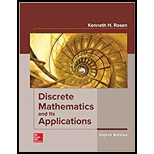
Concept explainers
Show that each conditional statement in Exercise 11 is a tautology by applying a chain of logical identities as inExample 8. (Do not use truth tables.)
11. Show that each of these conditional statements is a tautology by using truth tables.
a)
b)
c)
d)
e)
f)
Want to see the full answer?
Check out a sample textbook solution
Chapter 1 Solutions
DISCRETE MATHEMATICS+ITS APPL. (LL)-W/A
Additional Math Textbook Solutions
Pathways To Math Literacy (looseleaf)
Precalculus: Mathematics for Calculus (Standalone Book)
Elementary & Intermediate Algebra
College Algebra Essentials (5th Edition)
APPLIED STAT.IN BUS.+ECONOMICS
- not use ai pleasearrow_forward3) Let G be the group generated by elements a and b satisfying the relations a² = 63, 66 = 1, and a ¹ba = b¹. Which of the following is equivalent to the element z = a a-2ba3b3? A) b-2a-1 B) ab² C) ab D) ba E) b²aarrow_forward1) Find all complex solutions to cos(z) =arrow_forward
- 3) Compute where C is the circle |z― i| = - 1 2 2+1 Po z z - 2)2 dz traversed counterclockwise. Solution: TYPE YOUR SOLUTION HERE! INCLUDE A SKETCH OF THE COM- PLEX PLANE AND THE CURVE C. ALSO, MARK ALL SINGULARITIES OF THE INTEGRAND!arrow_forward2) Consider the function f (z = re²) = e cos(In(r)) + ie¯* sin(ln(r)). Show that is holomorphic at all points except the origin. Also show that =arrow_forward3) If a is a positive number, what is the value of the following double integral? 2a Love Lv 2ay-y² .x2 + y2 dadyarrow_forward
- 2) Consider the set SL(n, R) consisting of n x n matrices with real entries having de- terminant equal to 1. Prove that SL(n, R) is a group under the operation of matrix multiplication (it is referred to as the Special Linear Group).arrow_forward1) What is the parity of the following permutation? (1389) (24) (567)arrow_forward4.7 Use forward and backward difference approximations of O(h) and a centered difference approximation of O(h²) to estimate the first derivative of the function examined in Prob. 4.5. Evaluate the derivative at x = 2 using a step size of h = 0.2. Compare your results with the true value of the derivative. Interpret your results on the basis of the remainder term of the Taylor series expansion.arrow_forward
 Discrete Mathematics and Its Applications ( 8th I...MathISBN:9781259676512Author:Kenneth H RosenPublisher:McGraw-Hill Education
Discrete Mathematics and Its Applications ( 8th I...MathISBN:9781259676512Author:Kenneth H RosenPublisher:McGraw-Hill Education Mathematics for Elementary Teachers with Activiti...MathISBN:9780134392790Author:Beckmann, SybillaPublisher:PEARSON
Mathematics for Elementary Teachers with Activiti...MathISBN:9780134392790Author:Beckmann, SybillaPublisher:PEARSON
 Thinking Mathematically (7th Edition)MathISBN:9780134683713Author:Robert F. BlitzerPublisher:PEARSON
Thinking Mathematically (7th Edition)MathISBN:9780134683713Author:Robert F. BlitzerPublisher:PEARSON Discrete Mathematics With ApplicationsMathISBN:9781337694193Author:EPP, Susanna S.Publisher:Cengage Learning,
Discrete Mathematics With ApplicationsMathISBN:9781337694193Author:EPP, Susanna S.Publisher:Cengage Learning, Pathways To Math Literacy (looseleaf)MathISBN:9781259985607Author:David Sobecki Professor, Brian A. MercerPublisher:McGraw-Hill Education
Pathways To Math Literacy (looseleaf)MathISBN:9781259985607Author:David Sobecki Professor, Brian A. MercerPublisher:McGraw-Hill Education





